Using Machine Learning to Assess the Effects of Biochar-Based Fertilizers on Crop Production and N2O Emissions in China
Abstract
1. Introduction
2. Materials and Methods
2.1. Data Sources
2.2. Machine Learning
2.3. Marginal Benefit Analysis
2.4. Model Application
3. Results
3.1. Model Performance and Variable Importance
3.2. Impact of BBF on Crop Yield and N2O Emissions
3.3. Crop Productivity and N2O Emissions Reduction Under BBF Application
4. Discussion
4.1. Mechanisms for Enhancing Crop Yield and Reducing N2O Emissions Through BBF Application
4.2. Opportunities and Challenges of BBF in Agriculture
4.3. Limitations and Implication of This Study
5. Conclusions
Supplementary Materials
Author Contributions
Funding
Data Availability Statement
Conflicts of Interest
Abbreviations
| BBFs | Biochar-based fertilizers |
| BBF N/Mineral N | Proportion of nitrogen from BBFs in the total nitrogen input |
| BBF C/N | Carbon-to-nitrogen ratio of BBFs |
| RF | Random forest |
| SVM | Support vector machine |
| ANN | Artificial neural network |
| SOC | Soil organic carbon |
References
- Foley, J.A.; Ramankutty, N.; Brauman, K.A.; Cassidy, E.S.; Gerber, J.S.; Johnston, M.; Mueller, N.D.; O’Connell, C.; Ray, D.K.; West, P.C.; et al. Solutions for a cultivated planet. Nature 2011, 478, 337–342. [Google Scholar] [CrossRef] [PubMed]
- Mueller, N.D.; Gerber, J.S.; Johnston, M.; Ray, D.K.; Ramankutty, N.; Foley, J.A. Closing yield gaps through nutrient and water management. Nature 2012, 490, 254–257. [Google Scholar] [CrossRef]
- Lassaletta, L.; Billen, G.; Grizzetti, B.; Anglade, J.; Garnier, J. 50 year trends in nitrogen use efficiency of world cropping systems: The relationship between yield and nitrogen input to cropland. Environ. Res. Lett. 2014, 9, 105011. [Google Scholar] [CrossRef]
- Shcherbak, I.; Millar, N.; Robertson, G.P. Global metaanalysis of the nonlinear response of soil nitrous oxide (N2O) emissions to fertilizer nitrogen. Proc. Natl. Acad. Sci. USA 2014, 111, 9199–9204. [Google Scholar] [CrossRef]
- Stevens, C.J. Nitrogen in the environment. Science 2019, 363, 578–580. [Google Scholar] [CrossRef]
- Tian, D.; Niu, S. A global analysis of soil acidification caused by nitrogen addition. Environ. Res. Lett. 2015, 10, 024019. [Google Scholar] [CrossRef]
- Zhang, W.; Cao, G.; Li, X.; Zhang, H.; Wang, C.; Liu, Q.; Chen, X.; Cui, Z.; Shen, J.; Jiang, R.; et al. Closing yield gaps in China by empowering smallholder farmers. Nature 2016, 537, 671–674. [Google Scholar] [CrossRef]
- Paustian, K.; Lehmann, J.; Ogle, S.; Reay, D.; Robertson, G.; Smith, P. Climate-smart soils. Nature 2016, 532, 49–57. [Google Scholar] [CrossRef]
- Chen, W.; Meng, J.; Han, X.; Lan, Y.; Zhang, W. Past, present, and future of biochar. Biochar 2019, 1, 75–87. [Google Scholar] [CrossRef]
- Woolf, D.; Lehmann, J.; Ogle, S.; Kishimoto-Mo, A.; McCinkey, B.; Baldock, J. Greenhouse gas inventory model for biochar additions to soil. Environ. Sci. Technol. 2021, 55, 14795–14805. [Google Scholar] [CrossRef]
- Lehmann, J.; Joseph, S. (Eds.) Biochar for Environmental Management: Science, Technology and Implementation; Taylor & Francis: Abingdon, UK, 2024. [Google Scholar]
- Carbon Standards. Production of Biochar. 2025. Available online: https://www.carbon-standards.com/en/standards/service-514~production-of-biochar.html (accessed on 12 May 2025).
- Xia, L.; Cao, L.; Yang, Y.; Liu, Y.; Smith, P.; Van Groenigen, J.W.; Lehmann, J.; Lal, R.; Butterbach-Bahl, K.; Kiese, R.; et al. Integrated biochar solutions can achieve carbon-neutral staple crop production. Nat. Food 2023, 4, 236–246. [Google Scholar] [CrossRef]
- Jeffery, S.; Verheijen, F.G.A.; van der Velde, M.; Bastos, A.C. A quantitative review of the effects of biochar application to soils on crop productivity using meta-analysis. Agric. Ecosyst. Environ. 2011, 144, 175–187. [Google Scholar] [CrossRef]
- Schmidt, H.P.; Kammann, C.; Hagemann, N.; Leifeld, J.; Bucheli, T.D.; Sánchez-Monedero, M.A.; Cayuela, M.L. Biochar in agriculture: A systematic review of 26 global meta-analyses. GCB Bioenergy 2021, 13, 1708–1730. [Google Scholar] [CrossRef]
- Arunrat, N.; Uttarotai, T.; Kongsurakan, P.; Sereenonchai, S.; Hatano, R. Bacterial Community Structure in Soils With Fire-Deposited Charcoal Under Rotational Shifting Cultivation of Upland Rice in Northern Thailand. Ecol. Evol. 2025, 15, e70851. [Google Scholar] [CrossRef]
- Dong, D.; Li, J.; Ying, S.; Wu, J.; Han, X.; Teng, Y.; Zhou, M.; Ren, Y.; Jiang, P. Mitigation of methane emission in a rice paddy field amended with biochar-based slow-release fertilizer. Sci. Total. Environ. 2021, 792, 148460. [Google Scholar] [CrossRef]
- Clare, A.; Shackley, S.; Joseph, S.; Hammond, J.; Bloom, A. Competing uses for China’s straw: The economic and carbon abatement potential of biochar. GCB Bioenergy 2014, 7, 1272–1282. [Google Scholar] [CrossRef]
- Bach, M.; Wilske, B.; Breuer, L. Current economic obstacles to biochar use in agriculture and climate change mitigation. Carbon Manag. 2016, 7, 183–219. [Google Scholar] [CrossRef]
- Pan, G.; Li, L.; Liu, X.; Cheng, K.; Bian, R.; Ji, C.; Zheng, J.; Zhang, X.; Zheng, J. Industrialization of biochar pyrolysis: A new option for straw burning ban and green agriculture of China. Sci. Technol. Rev. 2015, 33, 92–101, (In Chinese with English abstract). [Google Scholar]
- Ndoung, O.; Figueiredo, C.; Ramos, M. A scoping review on biochar-based fertilizers: Enrichment techniques and agro-environmental application. Heliyon 2021, 7, e08566. [Google Scholar] [CrossRef]
- Joseph, S.; Graber, E.R.; Chia, C.; Munroe, P.; Donne, S.; Thomas, T.; Nielsen, S.; Marjo, C.; Rutlidge, H.; Pan, G.; et al. Shifting paradigms: Development of high-efficiency biochar fertilizers based on nano-structures and soluble components. Carbon Manag. 2013, 4, 323–343.3. [Google Scholar] [CrossRef]
- Melo, L.C.A.; Lehmann, J.; Carneiro, J.S.S.; Camps-Arbestain, M. Biochar-based fertilizer effects on crop productivity: A meta-analysis. Plant Soil 2022, 472, 45–58. [Google Scholar] [CrossRef]
- IPCC. Climate Change 2013: The Physical Science Basis; Stocker, T.F., Qin, D., Plattner, G.K., Tignor, M., Allen, S.K., Boschung, J., Nauels, A., Xia, Y., Bex, V., Midgley, P.M., Eds.; Cambridge University Press: Cambridge, UK, 2013. [Google Scholar]
- IPCC. Chapter 5: Cropland land. In 2019 Refinement to the 2006 IPCC Guidelines for National Greenhouse Gas Inventories: Agriculture, Forestry and Other Land Use; Blain, D., Agus, F., Alfaro, M.A., Vreuls, H., Eds.; Intergovernmental Panel on Climate Change (IPCC): Geneva, Switzerland, 2019; Volume 5, p. 68. [Google Scholar]
- Zheng, J.; Han, J.; Liu, Z.; Xia, W.; Zhang, X.; Li, L.; Liu, X.; Bian, R.; Cheng, K.; Zheng, J.; et al. Biochar compound fertilizer increases nitrogen productivity and economic benefits but decreases carbon emission of maize production. Agric. Ecosyst. Environ. 2017, 241, 70–78. [Google Scholar] [CrossRef]
- Shi, W.; Bian, R.; Li, L.; Lian, W.; Liu, X.; Zheng, J.; Cheng, K.; Zhang, X.; Drosos, M.; Joseph, S.; et al. Assessing the impacts of biochar-blended urea on nitrogen use efficiency and soil retention in wheat production. GCB Bioenergy 2022, 14, 65–83. [Google Scholar] [CrossRef]
- Liu, C.; Liu, Y.; Gao, W.; Gao, K.; Sun, B.; Zhang, X.; Xia, S.; Liu, X.; Li, L.; Pan, G. The effect of chamber placement site on N2O emission under different fertilizer regimes from maize field. Agric. Ecosyst. Environ. 2023, 341, 108210. [Google Scholar] [CrossRef]
- Li, H.; Wu, Y.; Liu, S.; Xiao, J.; Zhao, W.; Chen, J.; Alexandrov, G.; Cao, Y. Decipher soil organic carbon dynamics and driving forces across China using machine learning. Glob. Change Biol. 2022, 28, 3394–3410. [Google Scholar] [CrossRef]
- Lam, S.; Pan, B.; Qin, A.; Chen, D. Advancing agroecosystem modelling of nitrogen losses with machine learning. Earth Crit. Zone 2024, 1, 100006. [Google Scholar] [CrossRef]
- Huang, B.Y.; Lü, Q.X.; Tang, Z.X.; Tang, Z.; Chen, H.P.; Yang, X.P.; Zhao, F.J.; Wang, P. Machine learning methods to predict cadmium (Cd) concentration in rice grain and support soil management at a regional scale. Fundam. Res. 2024, 4, 1196–1205. [Google Scholar] [CrossRef]
- Xu, X.; Ouyang, X.; Gu, Y.; Cheng, K.; Smith, P.; Sun, J.; Li, Y.; Pan, G. Climate change may interact with nitrogen fertilizer management leading to different ammonia loss in China’s croplands. Glob. Change Biol. 2021, 27, 6525–6535. [Google Scholar] [CrossRef]
- Guilpart, N.; Iizumi, T.; Makowski, D. Data-driven yield projections suggest large opportunities to improve Europe’s soybean self-sufficiency under climate change. Nat. Food. 2022, 3, 255–265. [Google Scholar] [CrossRef]
- Sun, J.; Chen, L.; Ogle, S.; Cheng, K.; Xu, X.; Li, Y.; Pan, G. Future climate change may pose pressures on greenhouse gas emission reduction in China’s rice production. Geoderma 2023, 440, 116732. [Google Scholar] [CrossRef]
- Glenn, A.J.; Moulin, A.P.; Roy, A.K. Soil nitrous oxide emissions from no-till canola production under variable rate nitrogen fertilizer management. Geoderma 2021, 385, 114857. [Google Scholar] [CrossRef]
- Crane-Droesch, A. Machine learning methods for crop yield prediction and climate change impact assessment in agriculture. Environ. Res. Lett. 2018, 13, 114003. [Google Scholar] [CrossRef]
- Smith, P.; Smith, J.; Powlson, D.; McGill, W.; Arah, J.; Chertov, O.; Coleman, K.; Franko, U.; Frolking, S.; Jenkinson, S.; et al. A comparison of the performance of nine soil organic matter models using datasets from seven long-term experiments. Geoderma 1997, 81, 153–225. [Google Scholar] [CrossRef]
- Moran, D.; Macleod, M.; Wall, E.; Eory, V.; McVittie, A.; Barnes, A.; Rees, R.; Topp, C.F.E.; Moxey, A. Marginal abatement cost curves for UK agricultural greenhouse gas emissions. J. Agric. Econ. 2010, 62, 93–118. [Google Scholar] [CrossRef]
- Monfreda, C.; Ramankutty, N.; Foley, J.A. Farming the planet: 2. Geographic distribution of crop areas, yields, physiological types, and net primary production in the year 2000. Glob. Biogeochem. Cycles 2008, 22, GB1022. [Google Scholar] [CrossRef]
- SBS (State Bureau of Statistics). China Rural Statistical Yearbook; China Statistics Press: Beijing, China, 2019. [Google Scholar]
- FAO/IIASA/ISRIC/ISS-CAS/JRC (2012) Harmonized World Soil Database; Version 1.2; FAO: Rome, Italy; IIASA: Luxemburg, 2012.
- Ministry of Agriculture and Rural Affairs of the People’s Republic of China. Information Calendar. 2025. Available online: http://zdscxx.moa.gov.cn:8080/nyb/pc/calendar.jsp (accessed on 6 November 2024). (In Chinese)
- Wang, J.; Ma, W.; Jiang, R.; Zhang, F. Analysis about amount and ratio of basal fertilizer and topdressing fertilizer on rice, wheat, maize in China. Chin. J. Sci. 2008, 02, 329–333, (In Chinese with English abstract). [Google Scholar]
- NY/T3041-2016; Biochar Based Fertilize. Ministry of Agriculture and Rural Affairs: Beijing, China, 2016.
- Ye, L.; Camp-Arbestain, M.; Shen, Q.; Lehmann, J.; Singh, B.; Sabir, M. Biochar effects on crop yields with and without fertilizer: A meta-analysis of field studies using separate controls. Soil Use. Manag. 2020, 36, 2–18. [Google Scholar] [CrossRef]
- Dong, D.; Wang, C.; Van Zwieten, L.; Wang, H.; Jiang, P.; Zhou, M.; Wu, W. An effective biochar-based slow-release fertilizer for reducing nitrogen loss in paddy fields. J. Soils. Sediments 2020, 20, 3027–3040. [Google Scholar] [CrossRef]
- Yang, J.; Li, H.; Zhang, D.; Wu, M.; Pan, B. Limited role of biochars in nitrogen fixation through nitrate adsorption. Sci. Total. Environ. 2017, 592, 758–765. [Google Scholar] [CrossRef]
- Gao, S.; Peng, Q.; Liu, X.; Xu, C. The effect of biochar and straw return on N2O emissions and crop yield: A three-year field experiment. Agriculture 2023, 13, 2091. [Google Scholar] [CrossRef]
- Shi, W.; Ju, Y.; Bian, R.; Li, L.; Joseph, S.; Mitchell, D.R.G.; Munroe, P.; Taherymoosavi, S.; Pan, G. Biochar bound urea boosts plant growth and reduces nitrogen leaching. Sci. Total. Environ. 2019, 701, 134424. [Google Scholar] [CrossRef] [PubMed]
- Chew, J.; Zhu, L.; Nielsen, S.; Graber, E.R.; Mitchell, D.R.G.; Horvat, J.; Mohammed, M.; Liu, M.; van Zwieten, L.; Donne, S.; et al. Biochar-based fertilizer: Supercharging root membrane potential and biomass yield of rice. Sci. Total. Environ. 2020, 713, 13643. [Google Scholar] [CrossRef] [PubMed]
- Liu, C.; Tian, J.; Chen, L.; He, Q.; Li, Y.; Bian, R.; Zheng, J.; Cheng, K.; Xia, S.; Zhang, X.; et al. Biochar boosted high oleic peanut production with enhanced root development and biological N fixation by diazotrophs in a sand-loamy Primisol. Sci. Total. Environ. 2024, 932, 173061. [Google Scholar] [CrossRef]
- Liu, C.; Shang, S.; Wang, C.; Tian, J.; Zhang, L.; Liu, X.; Bian, R.; He, Q.; Zhang, F.; Chen, L.; et al. Biochar amendment increases peanut production through improvement of the extracellular enzyme activities and microbial community composition in replanted field. Plants 2025, 14, 922. [Google Scholar] [CrossRef]
- Castejón-del Pino, R.; Sánchez-Monedero, M.A.; Sánchez-García, M.; Cayuela, M.L. Fertilization strategies to reduce yield-scaled N2O emissions are based on biochar and biochar-based fertilizers. Nutr. Cycl. Agroecosyst. 2024, 129, 491–501. [Google Scholar] [CrossRef]
- Pereira, V.V.; Morales, M.M.; Pereira, D.H.; de Rezende, F.A.; de Souza Magalhães, C.A.; de Lima, L.B.; Marimon-Junior, B.H.; Petter, F.A. Activated biochar-based organomineral fertilizer delays nitrogen release and reduces N2O emission. Sustainability 2022, 14, 12388. [Google Scholar] [CrossRef]
- Chen, Y.K. Effects of Nitrogen Fertilizer Types on Greenhouse Gas Emissions and Nitrogen Use Efficiency of Rice and Oilseed Rape Cropping System. Master’s Thesis, Huazhong Agricultural University, Wuhan, China, 2022. (In Chinese). [Google Scholar]
- Yue, Q.; Wu, H.; Sun, J.; Cheng, K.; Smith, P.; Hellier, J.; Xu, X.; Pan, G. Deriving emission factors and estimating direct nitrous oxide emissions for crop cultivation in China. Environ. Sci. Technol. 2019, 53, 10246–10257. [Google Scholar] [CrossRef]
- Sun, J.F. Model Construction and Prediction of Future Changes in Carbon Sequestration and Emission Reduction Potential of Paddy Fields in China. Doctoral Dissertation, Nanjing Agricultural University, Nanjing, China, 2022. (In Chinese). [Google Scholar]
- Zhao, Y.; Wang, M.; Hu, S.; Zhang, X.; Ouyang, Z.; Zhang, G.; Huang, B.; Zhao, S.; Wu, J.; Xie, D.; et al. Economics-and policy-driven organic carbon input enhancement dominates soil organic carbon accumulation in Chinese croplands. Proc. Natl. Acad. Sci. USA 2018, 115, 4045–4050. [Google Scholar] [CrossRef]
- Sun, J.; Zheng, J.; Cheng, K.; Ye, Y.; Zhuang, Y.; Pan, G. Quantifying carbon sink by biochar compound fertilizer project for domestic voluntary carbon trading in agriculture. Sci. Agric. Sin. 2018, 51, 4470–4484, (In Chinese with English abstract). [Google Scholar]
- Qian, H.; Zhu, X.; Huang, S.; Linquist, B.; Kuzyakov, Y.; Wassmann, R.; Minamikawa, K.; Martinez-Eixarch, M.; Yan, X.; Zhou, F.; et al. Greenhouse gas emissions and mitigation in rice agriculture. Nat. Rev. Earth Environ. 2023, 4, 716–732. [Google Scholar] [CrossRef]
- Puga, A.P.; Grutzmacher, P.; Cerri, C.E.P.; Ribeirinho, V.S.; Andrade, C.A. Biochar-based nitrogen fertilizers: Greenhouse gas emissions, use efficiency, and maize yield in tropical soils. Sci. Total. Environ. 2020, 704, 135375. [Google Scholar] [CrossRef] [PubMed]
- European Union. Regulation (EU) 2019/1009 of the European Parliament and of the Council of 5 June 2019 laying down rules on the making available on the market of EU fertilising products and amending Regulations (EC) No 1069/2009 and (EC) No 1107/2009. Off. J. Eur. Union 2019, L170, 1. [Google Scholar]
- General Office of the Ministry of Agriculture and Rural Affairs of the People’s Republic of China. Notice on Recommending and Issuing Ten Models of Straw Farming Utilization. 2017. Available online: http://www.moa.gov.cn/govpublic/KJJYS/201705/t20170503_5593248.htm (accessed on 3 February 2025). (In Chinese)
- Ministry of Ecology and Environment of the People’s Republic of China. Greenhouse Gas Control. 2025. Available online: https://www.mee.gov.cn/ywgz/ydqhbh/wsqtkz/ (accessed on 3 February 2025). (In Chinese)
- Mostafa, M.E.; Hua, S.; Wang, Y.; Su, S.; Hu, X.; Elsayedd, S.A.; Xiang, J. The significance of pelletization operating conditions: An analysis of physical and mechanical characteristics as well as energy consumption of biomass pellets. Renew. Sustain. Energy Rev. 2019, 105, 332–348. [Google Scholar] [CrossRef]
- Meng, J.; He, T.; Sanganyado, E.; Lan, Y.; Zhang, W.; Han, X.; Chen, W. Development of the straw biochar returning concept in China. Biochar 2019, 1, 139–149. [Google Scholar] [CrossRef]
- Wang, C.; Luo, D.; Zhang, X.; Huang, R.; Cao, Y.; Liu, G.; Zhang, Y.; Wang, H. Biochar-based slow-release of fertilizers for sustainable agriculture: A mini review. Environ. Sci. Ecotechnol. 2022, 10, 100167. [Google Scholar] [CrossRef]
- An, X.; Wu, Z.; Yu, J.; Ge, L.; Li, T.; Liu, X.; Yu, B. High-efficiency reclaiming phosphate from an aqueous solution by bentonite modified biochars: A slow release fertilizer with a precise rate regulation. ACS Sustain. Chem. Eng. 2020, 8, 6090–6609. [Google Scholar] [CrossRef]
- Sim, D.H.H.; Tan, I.A.W.; Lim, L.L.P.; Hameed, B.H. Encapsulated biochar-based sustained release fertilizer for precision agriculture: A review. J. Clean. Prod. 2021, 303, 127018. [Google Scholar] [CrossRef]
- Vejan, P.; Khadiran, T.; Abdullah, R.; Ahmad, N. Controlled release fertilizer: A review on developments, applications and potential in agriculture. J. Control. Release 2021, 339, 321–334. [Google Scholar] [CrossRef]
- Clough, T.J.; Condron, L.M.; Kammann, C.; Müller, C. A review of biochar and soil nitrogen dynamics. Agronomy 2013, 3, 275–293. [Google Scholar] [CrossRef]
- Yu, Z.P.; Yang, H.P.; Ji, L.C.; Wei, C.C.; Jiang, F.; Li, M.S.; Li, X.L.; Li, F.Y. Effects of biochar-based fertilizer addition on maize yield and greenhouse gas emission characteristics. J. Henan Agric. Univ. 2022, 56, 742–749, (In Chinese with English Summary). [Google Scholar]
- Li, Z.D.; Tao, J.S.; Li, L.Q.; Pan, G.X.; Liu, X.Y.; Zhang, X.H.; Zhang, J.F.; Zheng, J.W.; Wang, J.F.; Yu, X.Y. Effects of biochar-based fertilizers on wheat yield and greenhouse gas emissions. Chin. J. Soil Sci. 2015, 46, 177–183, (In Chinese with English Summary). [Google Scholar]
- Li, X. Effects of Biochar and Biochar-Based Fertilizers on Greenhouse Gas Emissions, Maize Growth, and Soil Properties. Master’s Thesis, Nanjing Agricultural University, Nanjing, China, 2013. (In Chinese with English Summary). [Google Scholar]
- Li, Q.; Chen, L.; Joseph, S.; Pan, G.; Li, L.; Zheng, J.; Zhang, H.; Zheng, J.; Yu, X.; Wang, J. Biochar compound fertilizer as an option to reach high productivity but low carbon intensity in rice agriculture of China. Carbon Manag. 2014, 5, 145–154. [Google Scholar]
- Pramono, A.; Adriany, T.A.; Susilawati, H.L.; Sutriadi, M.T. Global warming potential from maize cultivation as affected by organic and biochar coated urea fertilizer in rainfed lowlan. IOP Conf. Ser. Earth Environ. Sci. 2021, 733, 012144. [Google Scholar] [CrossRef]
- Li, J.W. Effects of Long-Term Application of Biochar and Biochar-Based Fertilizers on Soil N2O Emissions and Nitrogen Fixation; Shenyang Agricultural University: Shenyang, China, 2022; (In Chinese with English Summary). [Google Scholar]
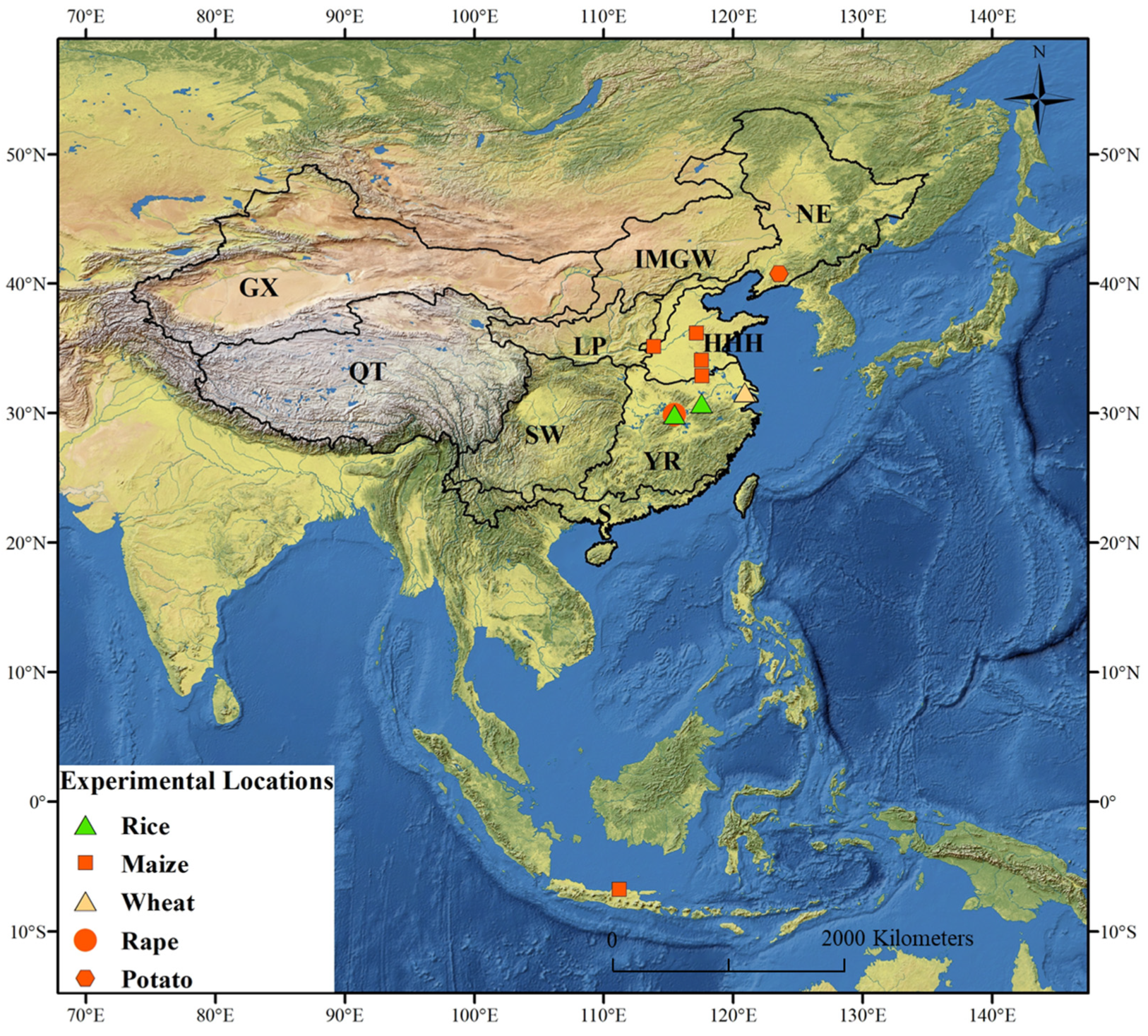

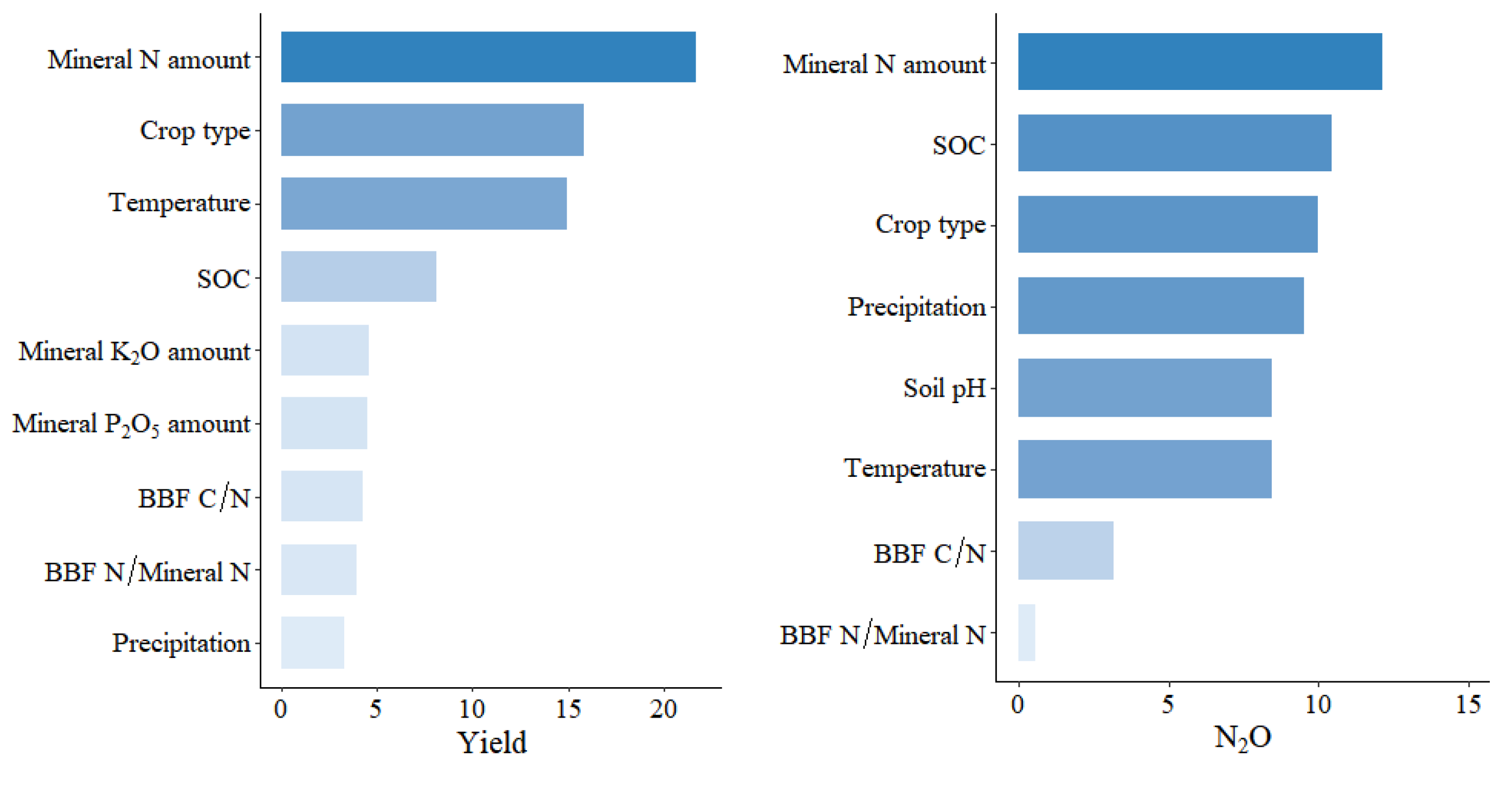
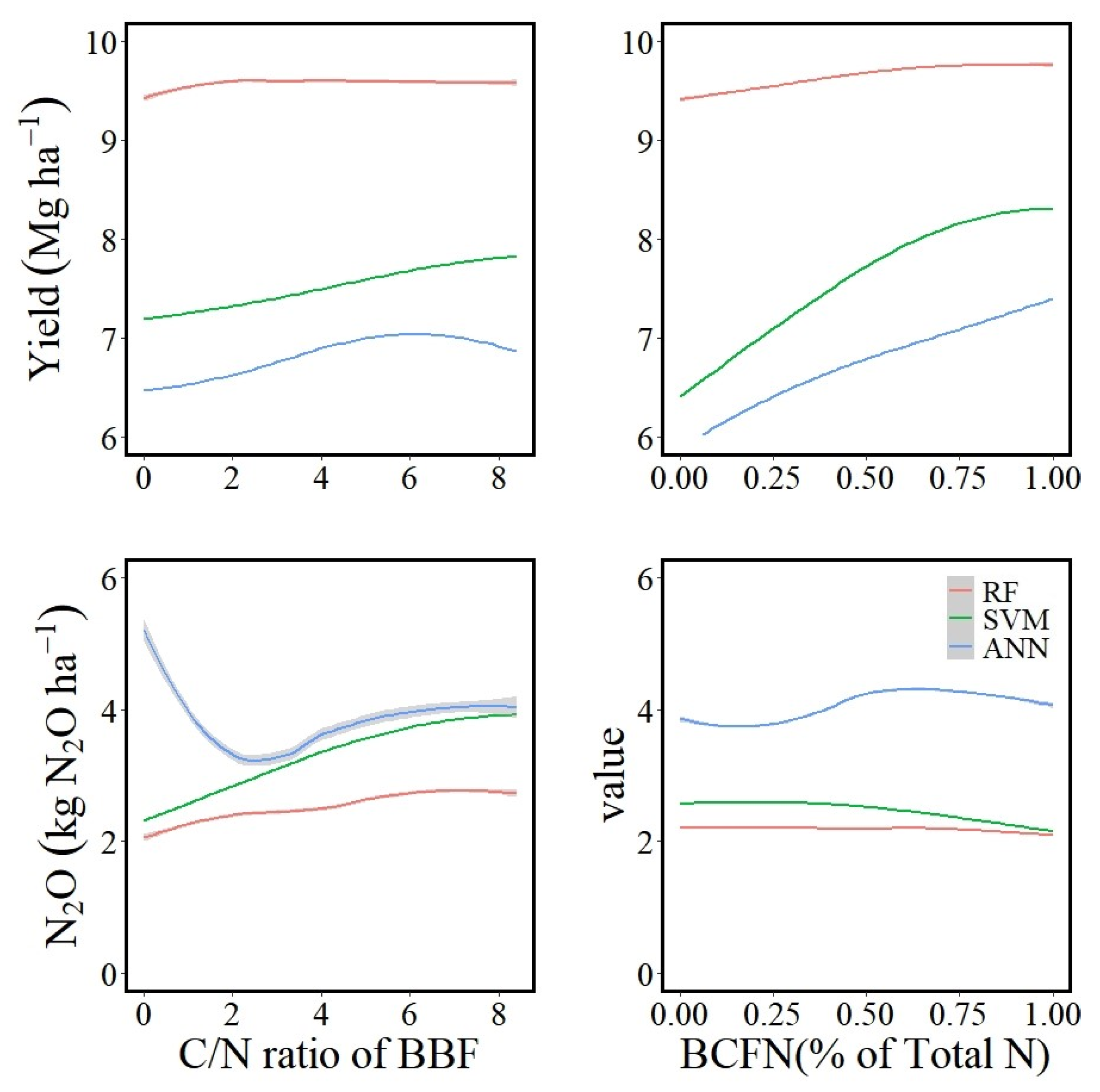
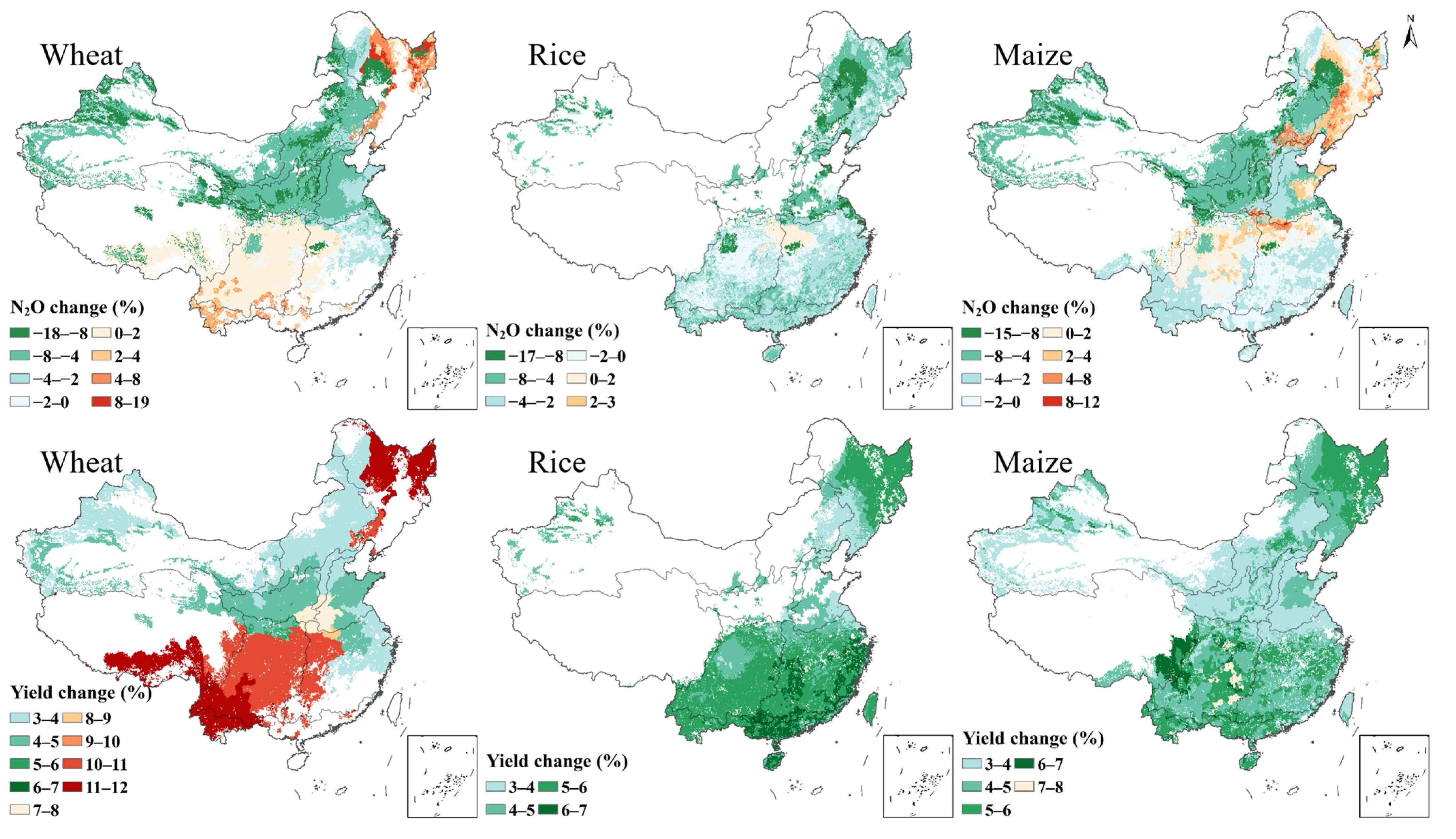
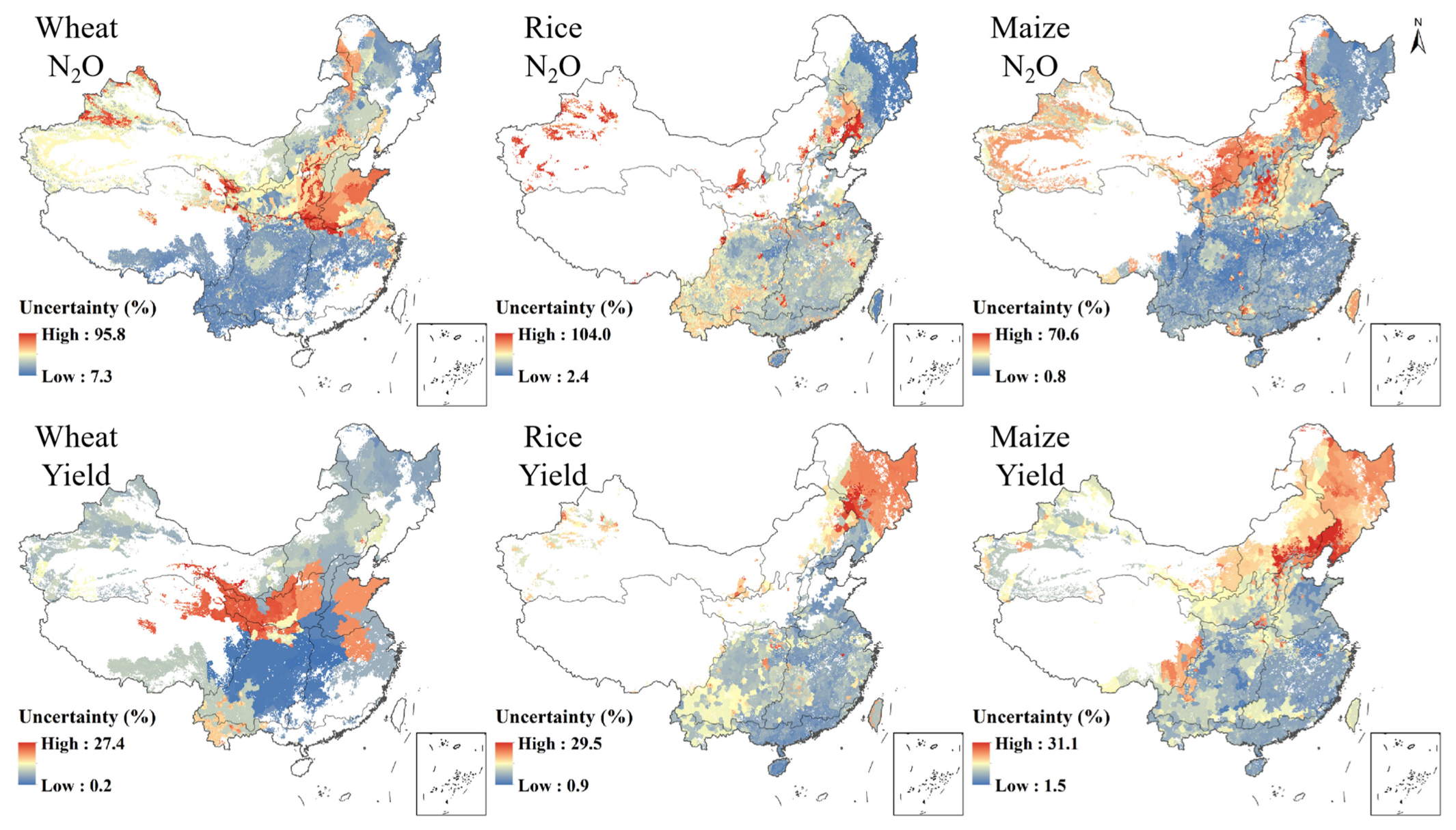
| Agricultural Region | Wheat | Rice | Maize | |||
|---|---|---|---|---|---|---|
| N2O Change (%) | Yield Change (%) | N2O Change (%) | Yield Change (%) | N2O Change (%) | Yield Change (%) | |
| NE | −6.95 | 4.31 | −5.60 | 5.47 | −3.50 | 4.69 |
| YR | −4.45 | 5.26 | −3.02 | 5.11 | −1.94 | 4.21 |
| SW | −2.17 | 8.57 | −3.68 | 4.71 | −1.53 | 4.84 |
| S | 1.42 | 11.49 | −2.77 | 5.36 | −2.47 | 4.80 |
| Others | −6.83 | 4.55 | −6.12 | 3.88 | −4.69 | 3.76 |
| National | −6.33 | 4.86 | −3.68 | 5.04 | −3.77 | 4.25 |
Disclaimer/Publisher’s Note: The statements, opinions and data contained in all publications are solely those of the individual author(s) and contributor(s) and not of MDPI and/or the editor(s). MDPI and/or the editor(s) disclaim responsibility for any injury to people or property resulting from any ideas, methods, instructions or products referred to in the content. |
© 2025 by the authors. Licensee MDPI, Basel, Switzerland. This article is an open access article distributed under the terms and conditions of the Creative Commons Attribution (CC BY) license (https://creativecommons.org/licenses/by/4.0/).
Share and Cite
Zeng, Y.; Chen, S.; Li, Y.; Xiong, L.; Liu, C.; Azeem, M.; Jie, X.; Chen, M.; Zhang, L.; Sun, J. Using Machine Learning to Assess the Effects of Biochar-Based Fertilizers on Crop Production and N2O Emissions in China. Agronomy 2025, 15, 1238. https://doi.org/10.3390/agronomy15051238
Zeng Y, Chen S, Li Y, Xiong L, Liu C, Azeem M, Jie X, Chen M, Zhang L, Sun J. Using Machine Learning to Assess the Effects of Biochar-Based Fertilizers on Crop Production and N2O Emissions in China. Agronomy. 2025; 15(5):1238. https://doi.org/10.3390/agronomy15051238
Chicago/Turabian StyleZeng, Yuan, Sujuan Chen, Yunpeng Li, Li Xiong, Cheng Liu, Muhammad Azeem, Xiaoting Jie, Mei Chen, Longjiang Zhang, and Jianfei Sun. 2025. "Using Machine Learning to Assess the Effects of Biochar-Based Fertilizers on Crop Production and N2O Emissions in China" Agronomy 15, no. 5: 1238. https://doi.org/10.3390/agronomy15051238
APA StyleZeng, Y., Chen, S., Li, Y., Xiong, L., Liu, C., Azeem, M., Jie, X., Chen, M., Zhang, L., & Sun, J. (2025). Using Machine Learning to Assess the Effects of Biochar-Based Fertilizers on Crop Production and N2O Emissions in China. Agronomy, 15(5), 1238. https://doi.org/10.3390/agronomy15051238






